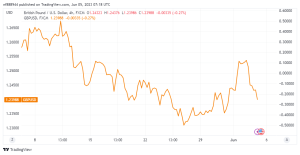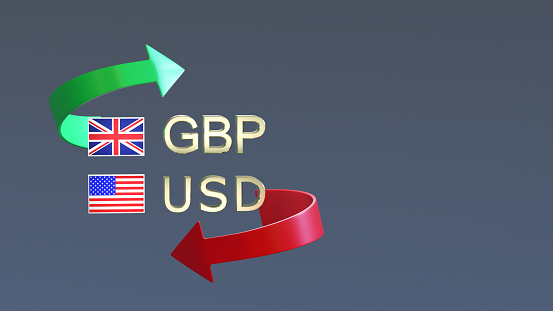The GBPUSD pair begins the new week on a weaker note. Extending its retracement decline from the mid-1.2500s, or the highest level since May 16, reached on Friday.
Bets on a 25-basis point Fed rate hike in June raise US bond rates and support the USD.
The US Dollar (USD) rose for the second day in a row. As investors awaited the Federal Reserve’s (Fed) next policy decision. It turns out to be a significant issue putting pressure on the main. It is worth noting that a plethora of powerful Fed officials This week bolstered the case for deferring an interest rate hike. While markets are still pricing in a 25-basis point increase in June. Furthermore, following the release of US monthly employment data on Friday. Investors appear to have pushed out expectations for an impending halt in the Fed’s rate hike campaign to July. And backed off on bets for rate cuts later in the year.
The risk-on environment may restrict gains for the safe-haven buck and minimize losses for the pair.
The headline NFP figure revealed that the US economy added 339K jobs in May, well above the previous month’s. Total of 294K and beyond consensus expectations of 190K.
However, additional information indicated. That the unemployment rate increased to 3.7%, opposed to a projected increase to 3.5% from 3.4% in April. Furthermore, Average hourly earnings fell from 4.4% to 4.3%, showing that pay growth is slowing. Nonetheless, the data was solid enough to sustain the Fed’s expectations for additional policy tightening. Sending US Treasury bond rates higher and supporting the Greenback. The existing risk-on climate, as shown by an optimistic tone in the financial markets. Appears to limit the safe-haven buck and may offer support to the GBPUSD pair.
The passing of legislation to raise the government’s $31.4 trillion debt ceiling. In order to avoid a historic American default continues to boost market confidence. According to a private-sector poll released on Monday. China’s services activity increased in May, boosting investor confidence. Aside from that, prospects for more interest rate rises by the Fed are increasing.
The Bank of England (BoE), buoyed by stronger-than-expected UK consumer inflation numbers for May, may help to minimize losses for the GBPUSD pair for the time being. As a result, it is wise to wait for strong follow-through selling before preparing for any big drop in spot prices. Traders are now looking for a fresh boost ahead of the US ISM Services PMI, which is coming later during the early North American session.
GBPUSD Technical Outlook
From a technical standpoint, the recent rebound from the 1.2300 area stalled at the 61.8% Fibonacci retracement line of the May drop.
The ensuing slip and acceptance below the 38.2% Fibo. level suggests a decrease towards the 1.2300 confluence support, which includes the 23.6% Fibo. level. on the 4-hour chart, as well as the 50-period Simple Moving Average (SMA). The handle should now operate as a critical milestone, and if it is convincingly broken, the bias will move back in favor of bearish traders, making the GBPUSD pair vulnerable to retesting last week’s swing low, around 1.2300.

On the other hand, momentum has returned above the 38.2% Fibo. level, around the 1.2450-1.2455 zone, and may now face resistance at the 1.2500 psychological barrier, marking the 50% Fibo. level.
This is followed by the 61.8% Fibo. level, which is located between 1.2535 and 1.2540, over which the GBPUSD pair may attempt to retake the 1.2600 round figure. The momentum may continue further towards the 1.2625-1.2630 intermediate obstacle en way to the YTD top, which is expected to be around the 1.2680 range.









